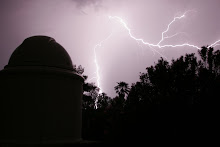
Last Friday night was the October meeting of the Tucson Amateur Astronomy Association. The guest speaker was Dr. Steve Howell, an NOAO astrophysicist who was fortunate to get observing time on the Spitzer Space Telescope.
Dr. Howell is studying dust in the region around binary stars. He's a very animated speaker and did a great job bringing some high-level theory down to the layperson realm. Observing dust is generally done in infrared wavelengths and it was interesting to hear his comparisons to optical observing (for example measuring wavelength in microns instead of Angstroms). Although these dust clouds would be extremely cold by human standards, they can be "hot" from an physics perspective, if there is an energy source available to heat them up.
He has interpreted his data to indicate the presence of a large dust disk surrounding certain binary star systems; the image above shows Dr. Howell in front of his closing slide, which is an artist's rendition of the dust glowing red around a binary system.
I'll have to keep all this in mind next time I'm working on a double star. Of course, the dust would never be visible, but it's always fun to let the mind wander and consider what is going on with the objects in the eyepiece.

No comments:
Post a Comment